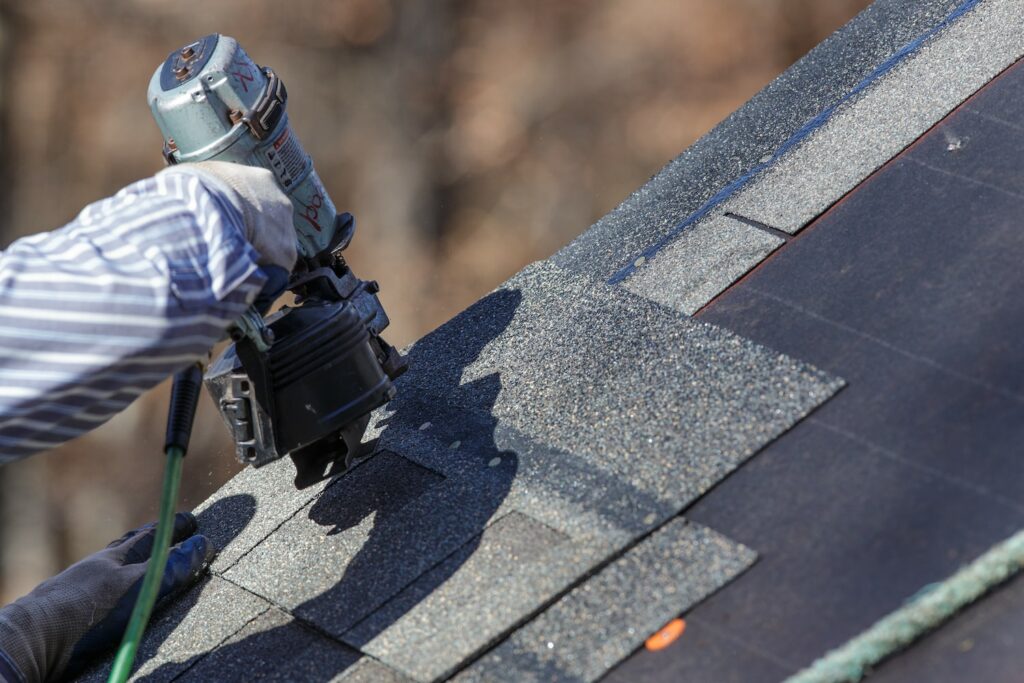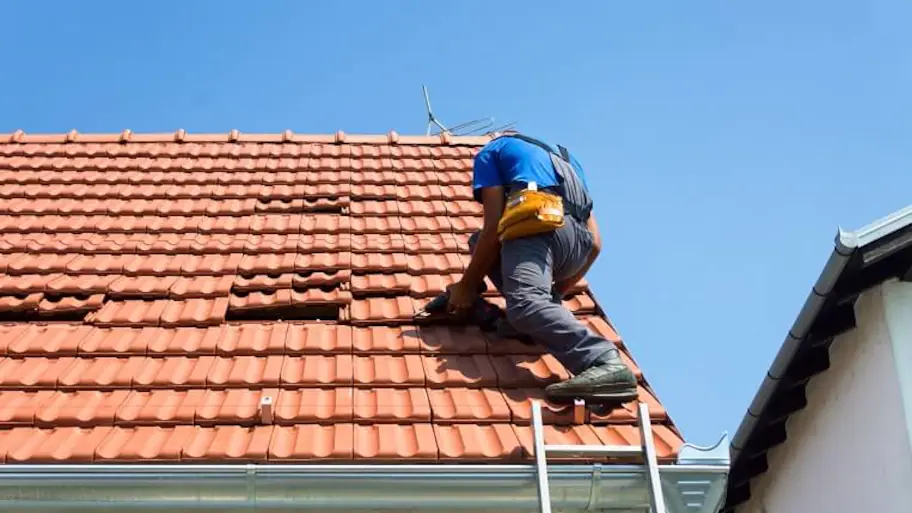Preventative Roofing System Maintenance: Tips to Prevent Costly Fixings
To avoid costly repairs, you need to evaluate your roofing consistently for missing or harmed tiles, clean your downspouts and seamless gutters to avoid obstructions, and trim looming branches. These basic steps can significantly extend your roof's life-span, and there's plenty much more you can do to protect your investment.
Evaluate Your Roofing Frequently
When you evaluate your roofing routinely, you can capture potential concerns before they end up being pricey repair services. Start by looking for missing out on, split, or curling shingles; these are signs that your roofing system might need attention. Look for any kind of visible wear around smokeshafts, vents, and flashing, as these areas are often susceptible to leakages. Pay attention to any type of sagging or irregular areas, which might indicate structural issues.
After a tornado, it's necessary to assess your roofing system for damage brought on by high winds or hefty debris. Don't neglect to check the underside of your roof in the attic room; appearance for signs of dampness or mold and mildew, which can suggest leakages. You must likewise watch out for granules in your seamless gutters, as they can indicate tile damage. By taking these steps, you'll lengthen your roof covering's life expectancy and conserve on your own from unforeseen costs. Regular examinations are key to maintaining a healthy and balanced roof.
Clean Seamless Gutters and Downspouts
Routine roof open this page covering inspections naturally result in an important task: cleaning your downspouts and gutters. Blocked seamless gutters can trigger water to back up, bring about prospective roofing leaks and architectural damages. To stop these issues, make it a behavior to examine your gutters at the very least twice a year, particularly after heavy tornados or fall when leaves gather.
When you cleanse them, begin by getting rid of particles like fallen leaves, twigs, and dust. You can use an inside story or your hands, but remember to put on handwear covers. After clearing the debris, flush the rain gutters with water to assure proper water drainage. Don't fail to remember to check downspouts for blockages. If water isn't moving easily, you could require to use a plumbing technician's snake or a tube to get rid of the blockage.
Address Overhanging Branches
Overhanging branches can position a severe threat to your roof, so it is necessary to cut them consistently. Not just can they create damages during tornados, but they can also invite pests. Make it a behavior to evaluate for any signs of wear or damages to maintain your roofing in leading shape.
Trim Consistently
Among the most essential action in roof upkeep is to trim those branches that hang as well near your home. Overhanging branches can create serious concerns, from debris buildup to prospective damages during tornados. Routinely cutting down these branches keeps your roof clear and lowers the risk of insects and leakages. Make certain to examine the health and wellness of the trees around your home; dead or weak branches posture an even higher danger. Objective to trim branches at the very least six feet far from your roofline, ensuring they will not enter into contact with your roof shingles. You do not need to tackle this job alone; employing a specialist arborist can assure efficient and secure cutting, safeguarding your roof covering and improving your home's total look.
Inspect for Damage
 roof repair
roof repair
Inspect for Harmed or Missing Roof Shingles
It's vital to examine your roof shingles regularly for any damages or missing out on items. Change missing roof shingles without delay to stop more troubles if you identify any kind of problems. Maintain an eye on exactly how the weather affects your roofing, as rough conditions can lead to tear and use.
Inspect Frequently for Damage
Routinely checking your roofing for damages is necessary to keeping its honesty and extending its life-span. Check your roofing after hefty tornados or solid winds, as these problems can remove or harm shingles. By making roof evaluations a routine part of your upkeep regimen, you can catch troubles early and save on your own from expensive repairs down the line.
Replace Missing Shingles Immediately
After checking for any type of damages during your examinations, you may discover that some shingles are missing or endangered. Don't wait to replace them; punctual action can stop further issues. Missing tiles reveal your roof to moisture, which can cause leakages and more extensive damages gradually.
Make certain to utilize tiles that match your roofing's shade and style for a seamless appearance. Maintaining your roofing in leading form is important for safeguarding your home and staying clear of pricey repair work down the line.
Screen Weather Condition Impact Often
As storms roll with your location, maintaining a close eye on your roofing becomes vital. After each storm, take a moment to evaluate your roof covering for any harmed or missing out on roof shingles. Climbing up onto the roof covering isn't always needed; you can usually detect issues from the ground with binoculars.
 roof repair
roof repairMake Certain Appropriate Ventilation
While numerous homeowners focus on the exterior and structural elements of their roofings, ensuring appropriate ventilation is essential for maintaining its durability and effectiveness. Poor air flow can lead to warmth buildup and dampness build-up, which can trigger damages over time.
Correct air flow not only enhances your roof's lifespan however additionally boosts energy effectiveness, maintaining your home comfy year-round. By taking these steps, you're investing in your roofing's wellness and staying clear of pricey repairs down the line.
Search for Indications of Leakages
Correct air flow aids protect against dampness buildup, yet despite having great air movement, it's important to watch out for indicators of leakages. Begin by examining your ceilings and walls for water stains or discoloration, which can suggest a leak above. Don't neglect to inspect your attic for moist places, mold, or mildew, as these can be early indication. Look for peeling off paint or bubbling wallpaper, too; these frequently signal moisture intrusion.
Outside, analyze your roof for missing out on shingles, splits, or damaged blinking, as these vulnerabilities can lead to leakages. Regularly examining for these signs will certainly assist preserve your roof's stability and keep your home completely dry and safe.
Schedule Expert Evaluations
 roof repair
roof repair
Go for at the very least one inspection each year, ideally in the springtime or loss, to align with seasonal adjustments. During these inspections, experts can determine prospective hazards like missing out on tiles, deteriorated flashing, or signs of mold. They'll additionally inspect for particles accumulation that might bring about water pooling.
Don't wait for visible indications of problem; taking aggressive actions can extend your roof covering's life expectancy. Spending in normal evaluations not only protects your home but likewise gives you peace of mind knowing your roofing is in good condition.
Often Asked Inquiries
How Commonly Should I Perform Roof Inspections?
You should do roofing system evaluations at the very least twice a year, ideally in springtime and loss. Normal checks assist you identify possible issues early, conserving you time and cash on expensive repair services down the line.
What Tools Do I Need for Roof Maintenance?
For roofing upkeep, you'll need a durable ladder, safety belt, roof covering nails, a hammer, an energy knife, caulk, a trowel, and a flashlight. Do not forget gloves and safety goggles to keep yourself protected!
Can I Clean My Roofing System Myself?
Yes, you can cleanse your roofing yourself. Simply make certain you have the right devices, wear safety equipment, and comply with correct strategies. It is very important to be mindful to avoid crashes and assure effective cleaning.
Exactly How Can I Identify Roof Covering Leaks Early?
To determine roofing system leaks early, you'll wish to check your roof covering routinely. Look for water spots, mold, or missing tiles. Listen after hefty rain, and don't wait to check the attic room for moist places.
What Are the Indicators I Need a New Roofing?
You'll require a new roof covering if you see curled or missing out on shingles, persistent leaks, or water spots on ceilings. Furthermore, if your roofing system's age goes beyond twenty years, it's sensible to consider replacement earlier instead of later.
To prevent costly repairs, you ought to check your roof covering on a regular basis for missing or damaged tiles, tidy your downspouts and rain gutters to protect against clogs, and trim looming branches. Missing out on tiles expose your roofing system to wetness, which can lead to leaks and more substantial damage over time.
After each tornado, take a minute to evaluate your roofing for any type of damaged or missing roof shingles.Outside, analyze your roof for missing roof shingles, fractures, or harmed blinking, as these susceptabilities can lead to leaks.To identify roof covering leakages early, you'll desire to examine your roofing regularly.